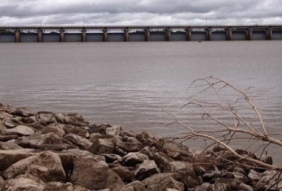
Posted on June 9, 2016
By Bryan Thompson, kmuw
Kansas owns water storage in 14 federal reservoirs managed by the U.S. Army Corps of Engineers. But the storage capacity of those lakes is gradually diminishing, as topsoil from waterways and farms upstream washes into the reservoirs and settles to the bottom.
As Heartland Health Monitor’s Bryan Thompson explains, state officials recently began trying to extend the life of the eastern Kansas reservoir where the problem is most critical.
The federal lakes were built mainly for flood control, but they’re also a crucial source of water. The reliability of that water supply in times of extended drought, however, is no longer a given. Two years ago, the state negotiated an agreement with the Corps of Engineers to raise the level of John Redmond Reservoir, near Burlington, by two feet. But Earl Lewis, the assistant director of the Kansas Water Office, says that didn’t solve the problem.
“It is absolutely the lake that’s in most urgent need of help. It’s more than 40 percent full of sediment,” Lewis says. “Some other reservoirs, like Tuttle Creek, like Toronto, are in that same neighborhood, but their demand isn’t quite to the point where they’re putting the same level of pressure that we see here at John Redmond, where our ability to supply is not meeting the demand that’s placed on these reservoirs.”
Lewis says in times of drought, the Neosho River could go completely dry without water releases from the lake. It came close to happening in 2012.
“The reservoir here went from full in May to down below 40 and even 28 percent by November, and so we saw a tremendous drop in the water supply in one year,” he says. “It really reinforced the fact that we don’t have enough storage here to make it through a prolonged drought.”
John Redmond supplies 19 communities and six industrial firms. It’s also a back-up source for the Wolf Creek nuclear power plant. In an effort to reclaim some of the lake’s storage capacity, state officials last month began a $20 million dredging project.
“What we’re doing is, we have a dredge in the water, and it’s like basically a big vacuum cleaner, and it sucks up the material, pumps it into a slurry line, and then we pump the material to a disposal area,” explains project engineer Brad Hahn.
Hahn is standing near a large, diesel-powered booster pump on the shore. It moves a thousand cubic yards of churned-up mud and water per hour from the dredge through six miles of 21-inch pipe to the containment ponds. There, the mud will settle out, and the water will be returned to the Neosho River.
The area being dredged is only a small fraction of the lake bottom in and around the original river channel, a few hundred yards from the dam. Hahn says the silt deposited in that area over the 50-year life of the lake is anywhere from five to 20 feet deep.
“As the sediment settles to the bottom, it raises the floor,” Hahn says. “So unless you raise the water level with it to maintain that water depth and that capacity, then you run out of capacity.”
This is the first large-scale dredging project to reclaim storage capacity the Corps of Engineers has ever approved. The state had to satisfy a host of environmental concerns, and the Corps had to make sure the dredging would in no way jeopardize the structural integrity of the dam.
The six-month, $20 million dredging project will add enough storage capacity to offset another three to five years of sedimentation. At a time when the state is struggling to keep its budget out of the red, that may not sound like a cost-effective expenditure. But Gov. Sam Brownback insists the state will be able to manage its budget.
“For years, our predecessors invested in these reservoirs for us, and we’ve gotten to use them,” he says. “And now this is our turn, and you’re not going to build a lot of new reservoirs across Kansas, or across America. That just not going to happen, so you’ve got to put money back in ‘em.”
Earl Lewis, of the Kansas Water Office, says dredging isn’t the most cost-effective way to approach the problem. The best solution is to prevent sediment from getting into the lakes in the first place. That’s why the Water Office is helping farmers minimize soil erosion, and covering fragile streambanks with rock or vegetation to keep them from washing away.
But under the best of circumstances, that will only reduce the sedimentation by about half. And with the lake already close to half-full of silt, Lewis says dredging is the only way to regain water storage capacity that’s already been lost.
Source: kmuw





